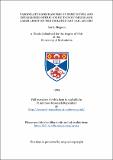Files in this item
Vasodilator mechanisms of some novel and established nitric oxide 'donor' drugs and laser light on the isolated rat tail artery
Item metadata
| dc.contributor.author | Megson, Ian L. | |
| dc.coverage.spatial | 194 p. | en_US |
| dc.date.accessioned | 2018-06-15T10:16:02Z | |
| dc.date.available | 2018-06-15T10:16:02Z | |
| dc.date.issued | 1994 | |
| dc.identifier.uri | https://hdl.handle.net/10023/14104 | |
| dc.description.abstract | The mechanism of action of some conventional (sodium nitroprusside, NP and S-nitroso-N-acetyl penicillamine, SNAP) and novel (iron-sulphur cluster nitrosyls) nitric oxide (NO) 'donor' drugs has been studied. Experiments were performed on segments of internally-perfused, rat isolated tail artery. Bolus injections (10µl) of SNAP and NP produce fully reversible (transient or T-type) vasodilator responses. Injections of Roussin's black salt (RBS), an iron-sulphur cluster containing 7 ligated nitrosyl groups, and a related cubane-like iron-sulphur cluster with 4 ligated nitrosyls (CUB), produce conventional T-type responses at doses below a critical threshold concentration (Dt). However, both compounds generate extraordinarily long- lasting (sustained or S-type) responses when the injected dose >Dt: these comprise an initial, rapid vasodilation, followed by partial recovery only. The resulting 'plateau' of reduced tone persists for several hours. Histochemical and X-ray microprobe analyses demonstrate that the plateau is due to slow release of NO from RBS or CUB taken up into the endothelium. RBS and CUB are also shown to be photosensitive: vasodilator responses to both compounds are potentiated by light. A study has also been made of the mechanism of vascular smooth muscle (VSM) photorelaxation. The phenomenon is shown to be due to release of NO from a photodegradable molecular store, which probably exists in the form of nitrosothiol(s), located in VSM cells. The store can be depleted by exposure to laser light, and then regenerated in the dark. The repriming process is dependent on basal release of NO: it is prevented by known inhibitors of NO synthase and by haemoglobin. Prior treatment of vessels with ethacrynic acid, a thiol alkylating agent, also prevents repriming. The therapeutic implications of these findings are discussed. | en_US |
| dc.language.iso | en | en_US |
| dc.publisher | University of St Andrews | |
| dc.subject.lcc | QP921.N5M3 | |
| dc.subject.lcsh | Individual chemical substances | en |
| dc.title | Vasodilator mechanisms of some novel and established nitric oxide 'donor' drugs and laser light on the isolated rat tail artery | en_US |
| dc.type | Thesis | en_US |
| dc.type.qualificationlevel | Doctoral | en_US |
| dc.type.qualificationname | PhD Doctor of Philosophy | en_US |
| dc.publisher.institution | The University of St Andrews | en_US |
This item appears in the following Collection(s)
Items in the St Andrews Research Repository are protected by copyright, with all rights reserved, unless otherwise indicated.

